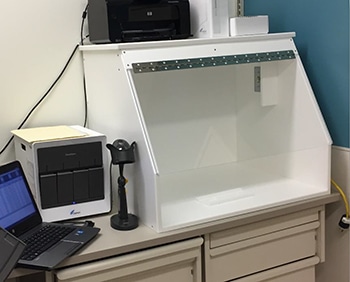Amy Carpenter Aquino
January 2021—The use of molecular assays at the point of care is exciting but a bit scary.
That’s how Raquel Martinez, PhD, D(ABMM), director of clinical and molecular microbiology at Geisinger Medical Laboratories, described the state of the science for molecular infectious disease POC testing when she spoke in a virtual AMP session in November with Omai Garner, PhD, D(ABMM), of UCLA Health.
“There are many ways for these molecular tests to go wrong, so testing sites need to introduce these tests carefully,” Dr. Martinez said, emphasizing the benefit to bringing highly sensitive molecular testing to the point of patient care.
When laboratories are not in control of the testing, she noted, there can be gaps in the understanding of environmental requirements, workflow, cleaning protocols, biosafety, and compliance.
“You know that feeling when you’re in the passenger seat and your foot is trying to hit the brakes and you realize you’re not the driver? It’s kind of like that,” she said. “As a laboratorian, I think that understanding the total testing process from sample to answer should be as well controlled at the point of care as it is in the laboratory.”
COVID-19 has temporarily forced the brakes on some infectious disease molecular POC testing initiatives at Geisinger, but the laboratory is still looking ahead with plans to introduce new biosafety precautions into the urgent care laboratory space and to take testing on the road with mobile units.
Since phasing out antigen POC testing in early 2013, Geisinger has been on a steady path of expanding molecular POC testing throughout its outpatient sites. In late 2016, Geisinger placed the Cepheid Xpert Flu/RSV XC in eight rapid response labs during the first phase of its FluWorks program. The strategy behind FluWorks was to distribute the fastest and most accurate tests throughout Geisinger’s 45-county service area while directing noncritical patients away from the emergency departments, saving emergency services for those who need them most and helping to keep wait times low.
Data reported in 2019 by Donna M. Wolk, MHA, PhD, D(ABMM), and colleagues at Geisinger showcased the program’s successes and how “implementing a molecular point-of-care testing algorithm can significantly impact outpatient outcomes,” Dr. Martinez said. “A 70 percent improvement in the collect-to-result time was observed in the study as well as a 15 percent reduction in antiviral utilization” (Hernandez DR, et al. Diagn Microbiol Infect Dis. 2019;94[1]:28–29).

Handmade molecular workstations protect staff from exposure to respiratory pathogens in Geisinger’s regional response laboratories.
In 2018, in phase two of the FluWorks program, molecular POC instruments were placed in Geisinger’s 23 urgent care centers.
Staff training in molecular microbiology, testing techniques, and template containment were key to the successful molecular POC testing implementation, Dr. Martinez said. Geisinger made and placed molecular workstations at each regional response laboratory to serve as a replacement for a traditional molecular dead-air box, which can be large and costly. “The workstation can withstand Clorox cleaning. We created the molecular workstations to ensure we had an additional level of containment for biosafety and for template control, should there be a spill.”
Geisinger’s path to molecular POC testing has had its share of speed bumps, starting with a thanks-but-no-thanks response from emergency medicine colleagues. “They originally declined molecular point of care,” citing lack of space near the EDs to triage patients to a non-ED route. For that reason, Geisinger Medical Laboratories is exploring mobile testing units, to be parked outside busy EDs for triage.
In addition, partnering with its community medicine team had a predictable negative impact on the laboratory’s revenue and productivity metrics. “We realized that without the laboratory team performing the tests, the revenue would move outside the laboratory,” Dr. Martinez said. And moving billable tests to another division had an impact on productivity metrics. “We knew it was the right thing to do and made plans to find a way to share and balance revenue and productivity in the future.”
The laboratory had to navigate different supply chains for inpatient and POC outpatient tests. And it took time to manage the extensive CLIA certificate applications for so many sites.

‘We plan to use it [the lab outreach vehicle] for deployments to areas
where there may be outbreaks.’
— Raquel Martinez, PhD, D(ABMM)
The laboratory hit its largest speed bump in 2020, when COVID-19 “caused us to put the brakes on a few things,” she said. “Because of the increased need for biosafety, we discontinued molecular point of care in our clinics, in the areas that could not confirm ample negative pressure in separate urgent care laboratory space. We felt that was an important requirement.” Geisinger is working to implement new negative pressure space where it’s needed. In the meantime, she said, “none of our remote testing sites are performing molecular point-of-care tests.”
“We also partnered with our chemistry point-of-care director, which is separate from the microbiology group, and together we decided to stop offering rapid strep testing as a point-of-care test in our clinic sites because of the increased risk for exposure to COVID-19,” Dr. Martinez said. “This is because traditionally, the rapid strep tests were performed out in the open, not under a hood or in a molecular workstation.” Rapid strep is performed now only in the hospital laboratories “while we reexamine the remote testing space.”
Because of the higher costs of using advanced practitioners, molecular POC testing will transition to phlebotomists and laboratory assistants as much as possible. But no matter who performs testing, Dr. Martinez said, having a molecular microbiologist oversee molecular POC testing at each site is non-negotiable. “We feel strongly that a dedicated microbiologist is required when venturing into molecular point of care.”
Looking past COVID-19, Geisinger’s laboratory is joining forces with its point-of-care and care gap teams to “take the show on the road” with its mobile clinic, Dr. Martinez said. “We are currently using a bus for health care screenings and disease prevention,” with services such as blood pressure readings and weight measurements to help meet health insurance and HEDIS measures.
“But in the future, we plan to offer A1c screenings and other point-of-care tests via the mobile bus,” she said. “The bus will be staffed with a phlebotomist, and we’ve discussed adding molecular point-of-care testing for infectious disease.”
Plans are also underway for special mobile units dedicated to delivering infectious disease POC testing. “We’re really excited about that. The Geisinger laboratory outreach vehicles”—known as LOVs—“are smaller vans and would not include patient appointments other than for testing. We plan to use it for deployments to areas where there may be outbreaks, such as specific facilities undergoing COVID-19 outbreaks, or to universities that would like us to do other types of screenings.”
For laboratories thinking about implementing COVID-19 POC testing, “I suggest that your infrastructure needs to be very strong before you even consider launching something as high impact as COVID-19 point-of-care testing,” said Dr. Garner, director of point-of-care testing and section chief, clinical microbiology, UCLA Health.
He and his UCLA colleagues have been working to bring up COVID-19 PCR testing and make it widely available for patients at UCLA Health, he said. “We’ve also been considering how we think about antigen testing or even point-of-care molecular testing and its usefulness within this space.” As the headlines have shown, he said, whether they’re about the White House or Nevada nursing homes, which had false-positive problems, “there have been relatively newsworthy, large-scale problems with point-of-care testing.”
All the more reason for a solid POC testing infrastructure, which is what he spoke about in the AMP session.
In the clinical laboratory, “there are structures in place to make sure the test result is as accurate as possible for patient care,” and POC testing falls outside that structure.
The Centers for Medicare and Medicaid Services identified sources of error in POC testing in 2000–2001 when it conducted a national survey of 436 physician office laboratories performing CLIA-waived POC tests. “Unfortunately, what they found was a very large set of errors,” Dr. Garner said, consisting mainly of test operator incompetence, nonadherence to procedure, and uncontrolled reagents and equipment.

‘Should these POC tests exclusively be performed in a BSC? Are there BSCs available in POC areas?’
— Omai Garner, PhD, D(ABMM)
Bringing the quality of POC testing to the required level is a primary goal, given the demand for quick diagnostic test results and the growth of the POC testing market. “Honestly, the tests themselves are getting better and better,” he said. “The sensitivity and specificity is achieving a level that can be had within the clinical laboratory when performed correctly.”
UCLA’s POC management program consists of inpatient POC testing at two large hospitals and outpatient testing at 200 primary care, urgent care, pediatric, and specialty clinics covering about 300 square miles. “I have more than 120 clinics that are performing point-of-care testing, so standardization can be a challenge in that setting,” Dr. Garner said.
One of the significant challenges to POC testing for SARS-CoV-2, he told CAP TODAY in December, is confirmatory PCR testing. “Which results need a follow-up PCR? Is a false-positive or a false-negative more impactful? I believe the answers to these depend on the patient population.” This is one of the reasons he and his team decided against POC COVID-19 testing, he says.
Another question: How would a POC area perform POC COVID-19 testing safely? “We have learned that patients infected with this disease can have very high viral loads in the respiratory tract. Should these POC tests exclusively be performed in a BSC? Are there BSCs available in POC areas? All of these are ongoing areas of concern.”
An unexpected challenge of the pandemic is the shortage of non-COVID-related tests. For example, UCLA’s POC testing sites used the Quidel hCG test for POC pregnancy testing on urine. “We were informed this summer that Quidel would no longer be able to supply that test because the company had pivoted to COVID-19 antigen test production. Because our POC infrastructure was in place,” Dr. Garner says, “we were able to pivot to a different POC hCG urine test as a system and maintain standardization.”
When he became director of the overall POC testing program for UCLA Health in 2014, he set out to analyze the quality of the program, and the first step was a survey of the EMR. The finding: The results in the EMR represented only about 40 percent of the overall POC testing volume. “We had access to the number of reagents ordered and used in the clinics, and we found that a huge number of tests were not being resulted in the appropriate place in the EMR.”
A closer look at the infectious disease POC testing monthly trends revealed that a substantial amount of flu antigen testing was taking place outside of the flu season.
Space constraints, too, were a problem, making it difficult to perform tests appropriately and adding to the concern about molecular POC testing.
“The last quality indicator we looked at was how the result was being input into the EMR,” Dr. Garner said. Not only were some POC testing results never recorded, but also there was a lot of variability in how the test performers entered the results in the EMR.
For example, only three results are possible for flu A and B rapid tests: positive, negative, or invalid if the test fails. An EMR with a drop-down list would automatically limit the number of unique entries, but UCLA’s free-text entry system inspired “people to get creative,” as Dr. Garner put it. Positive flu antigen test results were recorded with an array of letters and symbols: “pos, one plus sign, two pluses, three pluses, or a plus followed by two minuses.” The variability caused confusion.
“All of these things need to be taken into consideration when you’re considering point-of-care testing and the quality of that testing.”
The majority of infectious disease tests in the POC space are antigen tests based on a lateral flow architecture, similar to a home pregnancy test, Dr. Garner said. The patient sample containing analyte is placed on one side of the assay and flows by capillary flow across the test pad membrane, picking up antibodies along the way and leaving two lines. “There is a test line that’s going to sandwich that particular analyte, and a control line that’s going to capture any other antibodies that controls for the flow of the sample,” he said. If the test and control lines are both positive, the analyte is present.
“This is great, but the analyte needs to be there in abundance for this to work,” Dr. Garner said. “When I’m teaching this to my residents and fellows, we talk about how the eyeball is a poor reader by molecular interactions. The number of antigens that need to be here to get a relative signal so you can read it is high, much higher than something like PCR. So what we set up just by the assay itself is a lack of sensitivity if these testing methodologies are going to be used.”
“The challenge is when you get out of the 20 Ct window and start to move to 20 to 25, or 25 to 30 Cts,” where the sensitivity “falls a bit off the cliff” to as low as 50 percent, he said, referring to the CDC’s evaluation in 2009 of rapid antigen flu tests.
In 2015, realizing that antigen POC testing was inadequate from an infectious disease point-of-care perspective in patients with lower viral loads, Dr. Garner’s laboratory team began looking more closely at molecular-based POC testing. Comparisons in the literature of the Roche Cobas Liat Influenza A/B with the Alere i Influenza A&B, now known as the Abbott ID Now, “showed a potential lack of sensitivity of the Alere i in certain scenarios,” he said. The studies and sample types and handling were varied. “This was a similar story that I think has been repeated around the Abbott ID Now and other molecular tests for COVID-19.”
Dr. Garner and his team conducted their own evaluation of the Roche Cobas Liat and the Alere i platforms. The laboratory team used 150 deidentified nasopharyngeal specimens stored at -80°C in viral transport media from multiple flu seasons. “All of them had previously been confirmed on my Simplexa Flu A/B RSV PCR test that we were treating as the gold standard,” he said. The positive specimens were divided into 84 specimens positive for flu A and 16 specimens positive for flu B. Seventy-five specimens were negative for flu A/B but positive for rhinovirus or enterovirus. Twenty-five specimens were in viral transport media alone.
“We divided up the specimens by Ct value, similar to what the CDC did in the 2009 settings in comparing these two molecular platforms,” Dr. Garner said. “What we saw really mimicked what happened in the literature.”
The PCR-based Roche Cobas Liat “had a very equivalent sensitivity and specificity for flu A and flu B to our gold standard,” he said, whereas the Alere i “tended to suffer in its overall sensitivity.”
In a further effort to employ the right instrument for POC use, his team developed a user evaluation instrument study aimed at nurse educators, who were asked to compare the Liat and Alere i instruments based on the following 10 parameters:
- The instrument is easy to load and operate.
- The instructions for use are easy to follow and memorize.
- The graphical interface is easy to use.
- The test can be performed in a reasonable number of steps.
- Results are easy to interpret.
- Results are available in a timely manner.
- I will be able to confidently multitask while operating this instrument.
- The test is simple enough to be deployed in a POC setting.
- The test can easily fit into the general workflow of my practice.
- The instrument design reduces potential errors.
“All of this is critically important,” Dr. Garner said, “but we found that while the score was close, the Cobas Liat scored a bit higher than the Alere i in user evaluations.”
The lack of laboratory testing space is especially concerning for nucleic acid amplification testing because of the increased chance of operator error among POC testing staff. “Space constraint also potentially allows contamination between specimens,” leading to a risk of false-positives, Dr. Garner said. “Glove changing, surface cleaning, and things that we normally do in a molecular space are not possible in a cluttered space.”
“As an institution is considering rolling out point-of-care molecular testing, it really has to address problems like this. Get the infrastructure in place for quality before beginning that type of testing.”
Amy Carpenter Aquino is CAP TODAY senior editor.